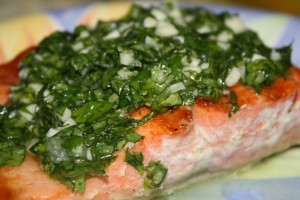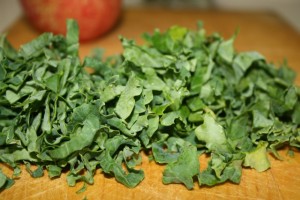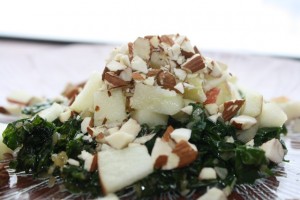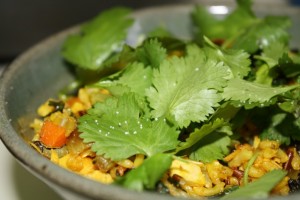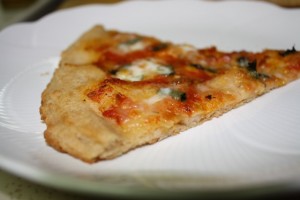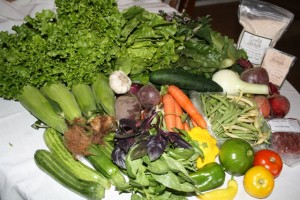11 Jan 2011
In Praise of Braises
What a busy week it’s been—the first of the year has brought some extra work in the ol’ accounting realm, leaving me little time to work on my, um, income-free projects. But at least I’ve had time to cook. The post-rent cash is rather scarce this week, so I’ve drawn from my freezer inventory. With a little invention, lots of delicious things landed on my plate, including a couple of braises and a new way to prepare butternut squash.
But first, the most recent dish: grilled salmon with cilantro-lime sauce, following the recipe from The Fishes & Dishes Cookbook, published this summer by Epicenter Press. (The authors, women who own and operate a fishing boat out of Alaska, also have a blog, available here. They visited Spokane over Labor Day weekend 2010, and I was lucky enough to attend a backyard dinner party for them, where they prepared this recipe.)
I had purchased a vacuum-sealed frozen fillet of wild Alaskan Sockeye salmon (just shy of two pounds) a while back and was waiting for an opportunity to share it with friends. So I took it out of the freezer a couple of days ahead to defrost slowly in the fridge then put the call out to a couple of friends for dinner. Sadly, they didn’t respond. That happens sometimes. But I had a thawed salmon, so I poured myself a wee glass of pinot noir and went ahead with my plans.
First I prepped the sauce. The cookbook’s directions call for using a food processor, but since I don’t have one I chopped, minced and stirred everything by hand instead of relying on technology. Here’s the deal: Mince four cloves of garlic, then mince the leaves from a bunch of cilantro. Add olive oil (2 to 4 tablespoons), the juice of one lime, and sea salt to taste. Stir it all up and let everything mingle nicely while you grill up the salmon according to your preferred method. (My preferred method is in a ridged grill pan on top of the stove, because that’s what I have.) Cook the salmon about 4 minutes per side (starting flesh side down) on a well-oiled grill or grill pan; top each cooked salmon portion with a generous dollop of the cilantro-lime sauce. Make mildly provocative noises of delight as you eat. (This won’t be difficult.)
This dish was also popular with the feline members of the household—other than during those few scary moments when I set off the smoke alarm while preheating the grill pan. In fact, Henry attempted Grand Theft Salmon while I was preoccupied with the aforementioned noises of pleasure. Luckily, he (and one chunk of salmon) landed on the floor with a thud, thus alerting the Authority (a.k.a., me). I rescued the salmon (mostly unharmed), invoking the famous (and sensible) five-second rule, and Henry ended up with a Kitty Time-Out as punishment.
Earlier in the week I had a chance to practice my braising skills, first with beef (a pound or so of round steak) and then with lamb (about a half-pound cut). Braising is one technique that I’ve seldom attempted, and I confessed my insecurity to a couple of chef friends last year. They both assured me that braising was simple but then rattled off several steps of instructions that left me dubious.
Perhaps it’s a coincidence, but within a few weeks each one offered a cooking class demonstrating several recipes—including a braise. I was thrilled and signed up for both classes. Once I actually witnessed the process, I realized that, yes, braising really is easy. It’s kind of like a cross between a browned stew (with less water) and a pot roast. I came away from those cooking classes last spring with copies of all the recipes demonstrated, so I decided to revisit two of them with some minor variations.
For the round steak, I modeled my dish on Chef Anna Vogel’s oxtail stew recipe—same seasonings, less water. And, of course, using my round steak instead of oxtails. (Not that I’m opposed to oxtails; I just had round steak in the freezer.) First, I sprinkled salt and pepper over my round steak and seared it in olive oil over medium-high heat in a deep skillet. When it was browned on both sides, I removed the beef from the pan and tossed in a handful each of chopped onion, celery and carrot, stirring everything around and cooking it until the onions became translucent. After returning the seared beef to the pan, I poured in some turkey stock (just because that’s what I had handy; you could use any meat or veggie stock, or even water) and red wine. Total liquid measured about 1 cup and did NOT cover the meat. I also added a clove of garlic, chopped, plus a bay leaf and a tiny pinch of thyme. After bringing the liquid to a simmer, I reduced the heat, covered the skillet and let it all cook together for an hour or so, until the meat was fall-apart tender.
Chef Anna’s stew recipe actually has several more steps—that’s what separates chef-artists from us mere mortals in the kitchen; well, that, plus way flashier knife skills—but at this point the beef and veggies were ready, by my reckoning. I served it with brown rice that night and had leftovers for two or three more meals (meaning that about a pound of beef would easily serve four, if that’s closer to your family size).
The next night, I took a smaller chunk of lamb (just a bit more than a half-pound) and set myself to braising again. This time I followed instructions from Chef Nicholas St. Clair, formerly of Café Marron and now in Atlanta. His recipe called for braising three lamb shanks, so I had to size things down considerably, but, again, I basically just took the recipe as a guidance plan and adapted accordingly.
Once again, I salted and peppered the meat, then seared it in olive oil. I pulled the meat from the pan then sautéed some diced onion; I added a clove of garlic, minced, and about a teaspoon of grated fresh ginger root. Next came some wine, less than a ¼ cup (I used red; Chef Nick called for white), 3 or 4 saffron threads, about a teaspoon of honey, part of a bay leaf, part of a cinnamon stick and maybe a tablespoon of raisins (the recipe called for dates, but I didn’t have any), all brought to a simmer. I returned the meat to the pan, making sure that the liquid didn’t cover it, then put a couple of sprigs of cilantro on top. At this point, Chef Nick’s recipe called for five hours, covered, in a 250-degree oven (which makes for incredibly tender and lip-smackin’-good lamb shanks), then reducing the sauce and finishing it with butter. But I wanted dinner sooner than that, so I chose to just cover the pan, turn the heat to low and let it simmer until tender, about 45 minutes. At that point, I took the cover off the pan and turned the heat up a notch, to reduce the liquid ever so slightly before serving. (Sorry, no photos of the braises–next time.)
The wonderful thing about braising, whether done in the oven or on top of the stove, is that you can turn an inexpensive cut of meat into a meal that’s full of flavor and richness. The characteristics that make a cut less desirable—bones, fat, connective tissues—become assets in the low moist heat of braising. There’s a lesson here, I think, about recognizing and developing the gifts that are presented to us—whether we’re talking about a cut of meat, or ourselves. If you take a round steak (or a blade steak or a chuck roast) and try to turn it into a rib-eye, you’ll be disappointed. But if you work with it, appreciate it for what it is, and cook it in a way that enhances its qualities, then you turn it into the best-possible round steak that it can be.
Using cuts of meat that some may consider substandard is also a way to eat sustainably. After all, I’ve never met a cow that’s all prime rib and tenderloin; somebody’s gotta eat the tougher, bony bits, and if I can braise ’em into tenderness while saving some money, I’ll gladly do it.
Braising takes time, plus knowledge that’s been lost (or at least misplaced) in the decades since our grandmothers’ time. And yet the rewards are great. Perhaps we need a renaissance of braising—along with canning and stewing and all those other lost food arts—not just as an exercise in artisanal foodways, but as a way to really make a difference in the lives of our neighbors who struggle to eat healthfully within ever-tightening budgets.

